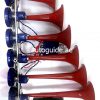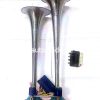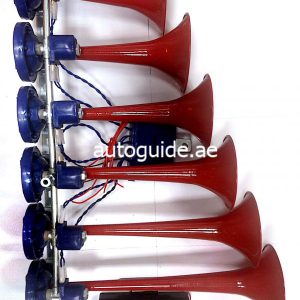3 Pipe Air Horn
Used for truck and trailers buses marine and all kind of heavy-duty vehicles
Description
- 3 Pipe Air Horn
- Type: pipe airhorn
- Brand: zam zam martin
- Lenth: 320 mm, 290 mm, 270 mm
- Sound: 5 musical sound
- Voltage: 24 volt
- Material: metal trumpet with back plastic body
- An air horn is a pneumatic device designed to create an extremely loud noise for signaling purposes. It usually consists of a source which produces compressed air, which passes into a horn through a reed or diaphragm. The stream of air causes the reed or diaphragm to vibrate, creating sound waves, then the horn amplifies the sound making it louder. Air horns are widely employed as vehicle horns, installed on large buses, semi-trailer trucks, fire trucks, trains, and some ambulances as a warning device, and on ships as a signaling device.
Operation 3 Pipe Air Horn
Diagram of a typical locomotive air horn power chamber, showing operation An air horn consists of a flaring metal or plastic horn or trumpet (called the “bell”) attached to a small air chamber containing a metal reed or diaphragm in the throat of the horn. Compressed air flows from an inlet line through a narrow opening past the reed or diaphragm, causing it to vibrate, which creates sound waves. The flaring horn serves as an acoustic impedance transformer to improve the transfer of sound energy from the diaphragm to the open air, making the sound louder. In most horns it also determines the pitch of the sound. When vibrated by the diaphragm, the column of air in the horn vibrates in standing waves. The length of the horn determines the wavelength of the sound waves generated, and thus the fundamental frequency (pitch) of the note produced by the horn. The longer the horn, the lower the pitch.
Larger air horns used on ships and foghorns function similarly to a whistle; instead of a diaphragm the air escapes from a closed cylindrical resonator chamber through a precisely shaped slit directed against a knife edge (fipple). The air blowing past the knife edge oscillates, creating sound waves. The oscillations excite standing waves in the resonator chamber, so the length of the chamber determines the pitch of the note produced.
Trucks and buses 3 Pipe Air Horn
In trucks and buses, the air horn is powered with compressed air from the vehicle’s air brake system. In trucks, a cord mounted on the ceiling of the operator’s cab is pulled or in buses, a valve lever on the side of the dashboard is pushed down or pulled up to open the valve, supplying varying amounts of air to the horn. Thus, an outstretched hand reaching upward and pumping is a signal to the driver of an air horn equipped vehicle, requesting a toot. In modern trucks and buses, the horn is actuated by a button on the steering wheel (just like a normal car horn). Some trucks and buses have both electric and air horn, selectable by a switch on the dashboard. This is to prevent the use of the powerful air horn in populated areas.
Emergency vehicles
Many fire trucks, ambulances, and other large emergency vehicles operate air horns as a means of warning vehicles to clear the right-of-way.
There are also electronic horns for emergency vehicles, which produce a similar easily recognizable sound. These are typically integrated into the same system as the vehicle’s electronic siren, and sound through the same speakers. In the last several decades, electronic sound systems with more widely varying frequencies have been chosen as common supplemental warning systems.
Locomotives 3 Pipe Air Horn
Leslie model S5T five-chime locomotive air horn. Originally, diesel locomotives were equipped with truck horns. After an accident in which a driver mistook a train for a truck, the need for a unique-sounding train horn became clear.[1] Consequently, North American trains now have at least two horns with different tones forming the airhorn, that sound simultaneously,[citation needed] creating a harmonic interval or chord. Each individual horn is called a “chime”. Three and five-chime configurations are the most common, but two chime horns also exist.[2]
Fifteen to twenty seconds before entering a level crossing, federal law requires locomotives to sound their horns in a standard warning sequence. This succession consists of two long, one short, and one long horn sounding repeated as necessary until the locomotive clears the crossing. Exceptions to federal law occur in locations with established quiet zone ordinances that prohibit sounding locomotive horns.
In recent years, it has become a fad for bicycle, car, and truck enthusiasts to install large air horns on their vehicles.[3] Some jurisdictions do not allow an airhorn to be attached, whether or not it can be activated.
Only logged in customers who have purchased this product may leave a review.








Reviews
There are no reviews yet.